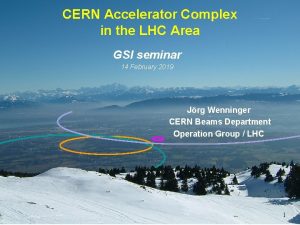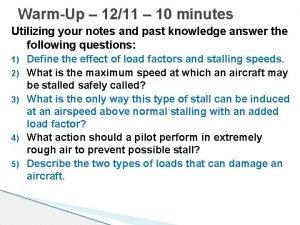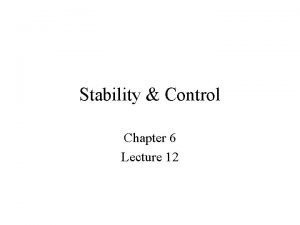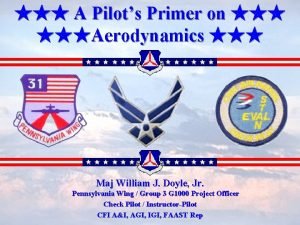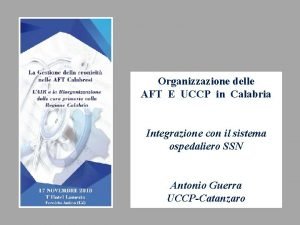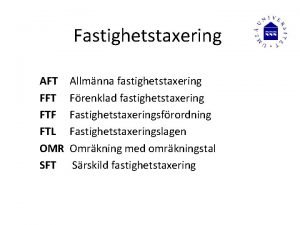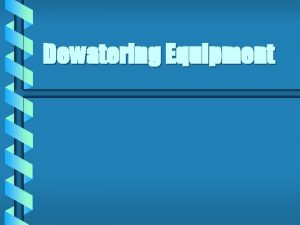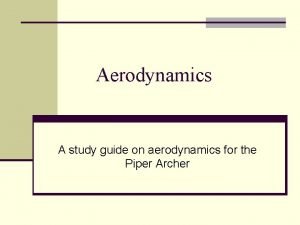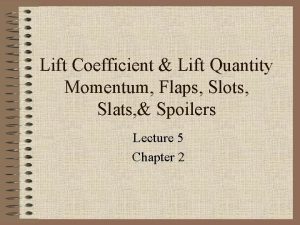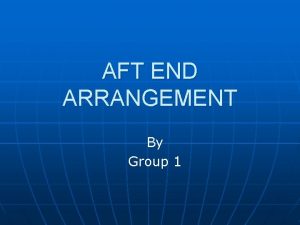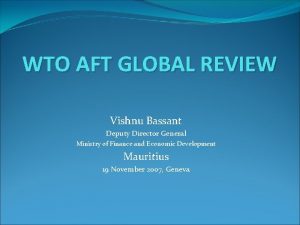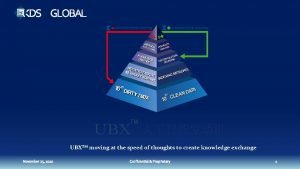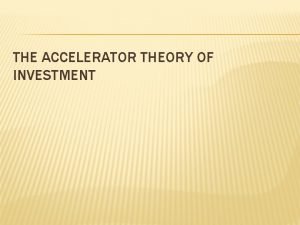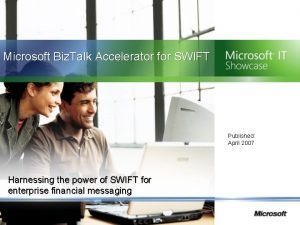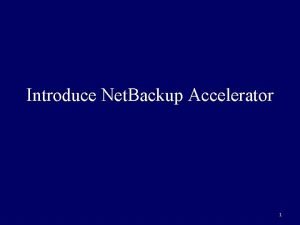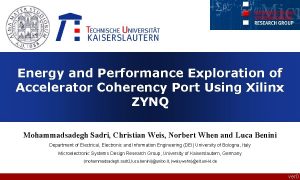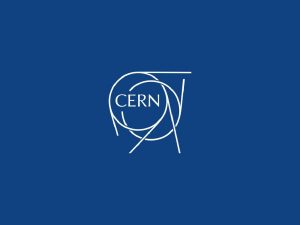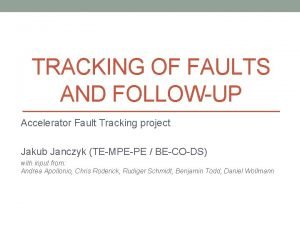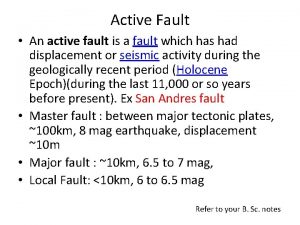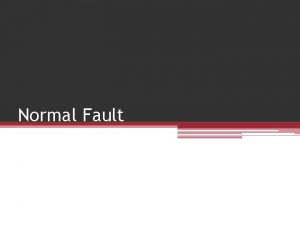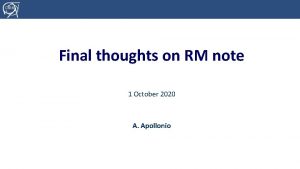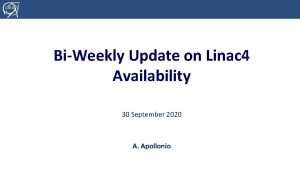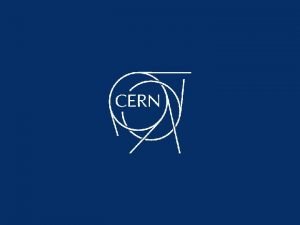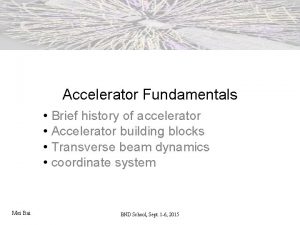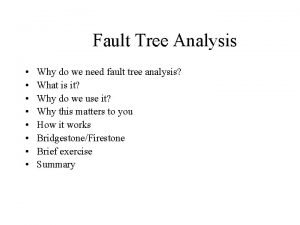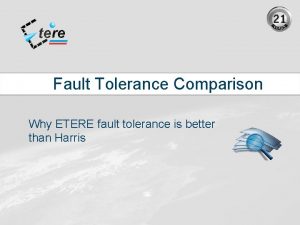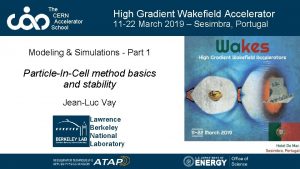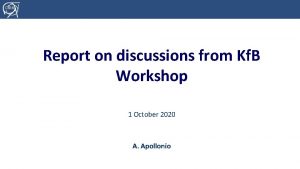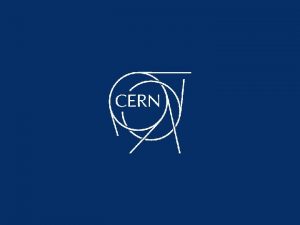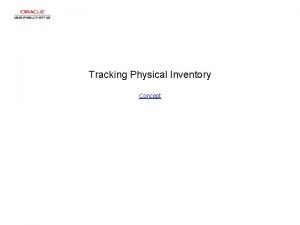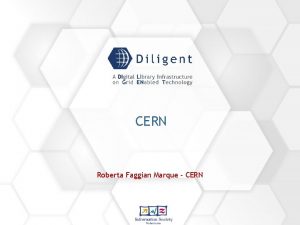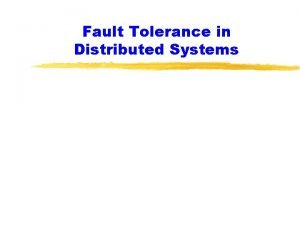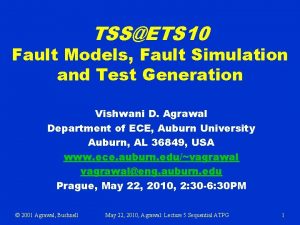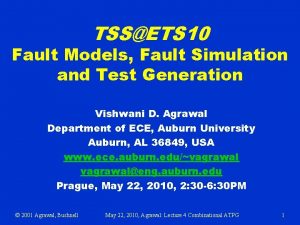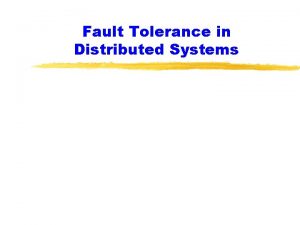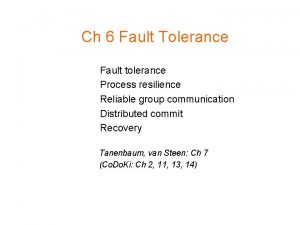CERN Accelerator Fault Tracking AFT Why was it


























- Slides: 26

CERN Accelerator Fault Tracking AFT: Why was it invented? For CERN’s Accelerator Complex May 2019 A. Apollonio (TE-MPE) C. Roderick (BE-CO) Andrea Apollonio & Chris Roderick page 1

Accelerator Fault Tracker: What is it? CERN Operators register faults – providing a very broad overview of accelerator behavior, but lacking details for system improvements AFT is a software application to: Ensure consistent and objective fault tracking for the CERN accelerator complex System experts register faults via dedicated tools (Jira, AMMSs, Excel, etc. ) that are not easily shared – resulting in a very detailed system specific view, but lacking information on overall accelerator impact Andrea Apollonio & Chris Roderick page 2

AFT: Why was it invented? CERN Beam Performance KPI = Integrated Luminosity Hardware Performance Operational Efficiency = Availability Andrea Apollonio & Chris Roderick page 3

AFT: What does it do? CERN Fast, powerful and objective reporting on accelerator performance Enabling to: Prioritize consolidation activities according to impact on availability Maximize return of investment given allocated budget constraints Provide input for modelling of accelerator projects Andrea Apollonio & Chris Roderick page 4

AFT History… CERN LHC Availability Working Group (AWG) launched (chairs: B. Todd, L. Ponce, sc. Secretary: A. Apollonio), reporting to LHC Machine Committee 2012 Accelerator Fault Tracker (AFT) proposed to have objective view of LHC availability B. Todd / L. Ponce / A. Apollonio together invented Cardiogram data view C. Roderick joined as partner from Controls 2013 2014 2015 AFT project launched (combined BE-CO, BE-OP and TE-MPE initiative) AFT extensively used for LHC availability data analysis and predictive models of accelerator performance AWG periodic LHC reporting using AFT data CERN Machine Advisory Committee recommendation: extend AFT to entire CERN complex 2016 2017 AFT extensively used for CERN-wide availability data analysis AWG began periodic reporting for injectors using AFT data LHC = B. Todd / A. Apollonio / D. Walsh, Injectors = A. Apollonio, A. Niemi 2018 On-going developments (BE-CO), with requirements from AWG, BE-OP and several ATS equipment groups Andrea Apollonio & Chris Roderick page 5

Fault Registration Workflow CERN OP crew registers faults LHC OP e. Logbook AWG core reviews faults System experts review faults AFT Statistics & Reports SPS OP e. Logbook PSB OP e. Logbook Linac OP e. Logbook Andrea Apollonio & Chris Roderick page 6

Fault Registration CERN Operators use existing E-Logbook Tool AFT Web application also available In both cases – the fault capture is intended to be as simple as possible Andrea Apollonio & Chris Roderick page 7

AFT High-Level Overview CERN Spring JPA AFT DB Storing fault data plus filtered data coming from other systems to be correlated with fault details REST API Web application: browse, edit and analyse fault data. AFT server RMI (REST soon) REST APIs Logging Client (Java) Layout (faulty elements), ASM (schedule data) Andrea Apollonio & Chris Roderick Logging System (archived data) – machine info (beam modes etc. ) e. Logbook – basic fault data from Operators page 8

Alarm and Interlock Systems CERN ● Alarm systems are mostly used for diagnostics of faults (accelerators + technical infrastructure) Requires accurate configuration Easier to use in smaller machines Direct interface with operators to identify faults Today not in use for LHC, too many alarms, practically unmanageable ● Interlock systems are used for machine protection Cannot be bypassed by operators Reaction time (LHC) ~100 us Also provide accurate fault diagnostics via the post-mortem system Absolutely vital for LHC operation, extremely stringent reliability requirements Andrea Apollonio & Chris Roderick page 9

A Data-Driven Approach CERN AFT is largely data-driven – based on configuration data stored in a relational model. This includes definitions of: ● Accelerators (facilities) ● Accelerator Specific Fault Properties (e. g. affected ring for the CERN PSB, LHC R 2 E status, etc. ) ● Accelerator Systems ● Accelerator System Responsibles ● Accelerator System Specific Fault Properties (e. g. Technical Infrastructure Failure Modes, Electrical Network distribution site locations, Controls JIRA issue keys) etc. ● Etc. Andrea Apollonio & Chris Roderick page 10

CERN Andrea Apollonio & Chris Roderick Cardiogram of LHC Operation page 11

Customisable Event Details CERN Review Status Basic Information Details and History Event Dependencies Attributes Andrea Apollonio & Chris Roderick History of changes page 12

Customisable Event Details CERN Details and History Attributes Andrea Apollonio & Chris Roderick page 13

CERN Objective view of 2017 LHC System Downtime System Viewpoint = Integrated fault time logged Operations Viewpoint = Corrects for dependencies parent / child / shadow Andrea Apollonio & Chris Roderick page 14

Background CERN Complete & Consistent Tracking will allow to identify: • Problems as early as possible ☞ allowing for timely mitigation • Key issues which will limit performance of accelerators or equipment (Run 3, HL-LHC, …) Aim: Increase availability, both short and long-term, by dealing with issues ASAP Track faults in two areas: 1. Directly affecting accelerator operation – identify root causes 2. Equipment faults independently of immediate impact on accelerator operation Andrea Apollonio & Chris Roderick page 15

Current Status CERN AFT is the common source for regular performance reporting: Weekly Facilities Operation Meetings, LHC Machine Coordination meetings, Post Technical Stops, Annual Performance workshops (Evian) etc. Steadily providing new features and improvements >450 users (~250 regular users) Extension foreseen to cover SPS North Experimental Area from 2020 onwards Andrea Apollonio & Chris Roderick page 16

Roles and Privileges CERN All access requires a login via CERN Single Sign On. Your role dictates what you can do inside AFT. Roles use RBAC (Role Based Access Control). Main Roles: AWG Members (Availability Working Group) & Machine Supervisors: power users, responsible for overall data quality, arbitrating between operators and equipment groups, producing periodic reports. Operators: responsible for initial data entry / edition. System Experts: responsible for validating and completing data for faults assigned to their system(s). Other users: have read access, are able to comment etc. Andrea Apollonio & Chris Roderick page 17

Fault Review Process CERN AWG members and Machine coordinators meet periodically (weekly for the injectors) to review the faults: completing missing data, ensuring consistency across the machines, and adding relationships between the faults where applicable. System Experts are notified of new faults either immediately after they are assigned or periodically (weekly) according to the system experts preferences. • Invited to review the faults assigned to their system - essentially acknowledging the fault. • Able to update certain attributes. • Can request modification of remaining attributes by AWG (e. g. change of times, states, reassignment to another system etc. ). Workflow behind, whereby the AWG/Machine Coordinators are able to see and accept / reject modification requests. This is the best / easiest way to work - i. e. don’t just send mails or make comments asking for things to be re-assigned. Andrea Apollonio & Chris Roderick page 18

CERN Conclusions / Personal remarks Raising awareness of the importance of fault tracking and fault follow-up in the organization is fundamental Make fault tracking credible, objective and visible to all accelerator experts Establish a clear workflow for fault registration and review, involve operations, technical experts, management Automatic fault registration is the dream…may be not so easy in some cases Takes time…(several years, if not implemented from the beginning) Andrea Apollonio & Chris Roderick page 19

CERN aft. cern. ch Andrea Apollonio & Chris Roderick page 20

CERN Andrea Apollonio & Chris Roderick page 21

CERN Andrea Apollonio & Chris Roderick page 22

CERN Andrea Apollonio & Chris Roderick page 23

CERN Andrea Apollonio & Chris Roderick page 24

CERN Andrea Apollonio & Chris Roderick page 25

CERN Andrea Apollonio & Chris Roderick page 26
 Cern accelerator complex
Cern accelerator complex Cern accelerator school 2021
Cern accelerator school 2021 Why why why why
Why why why why Openreach fault tracker
Openreach fault tracker Forward cg aft cg
Forward cg aft cg Forward vs aft cg characteristics
Forward vs aft cg characteristics Keel surface aircraft
Keel surface aircraft 2 man fireman's carry
2 man fireman's carry Aft cg vs forward cg
Aft cg vs forward cg Pyramide classement tennis 2021
Pyramide classement tennis 2021 Fantail ship
Fantail ship Aft vs forward cg
Aft vs forward cg Uccp significato
Uccp significato Aft
Aft Objectives of dewatering
Objectives of dewatering How to calculate maneuvering speed
How to calculate maneuvering speed Aft momentum flap
Aft momentum flap Cruiser stern and transom stern
Cruiser stern and transom stern Aft global
Aft global Aft prepayment and credit model
Aft prepayment and credit model Dont ask
Dont ask Transformational leadership questionnaire
Transformational leadership questionnaire Accelerator theory of investment
Accelerator theory of investment Biztalk swift
Biztalk swift Netbackup accelerator track log
Netbackup accelerator track log Fiscal policy ib
Fiscal policy ib Accelerator coherency port
Accelerator coherency port
